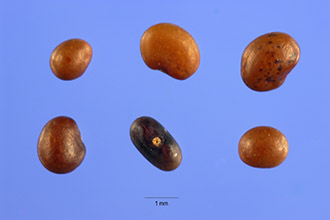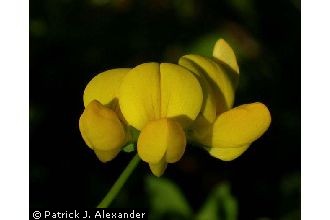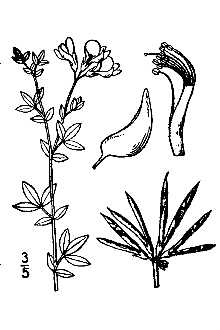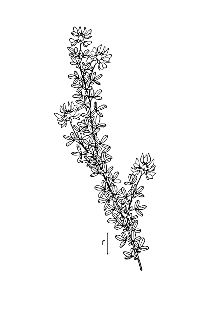Bird's-foot Trefoil
Scientific Name: Lotus corniculatus L.
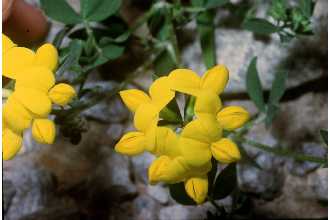
| General Information | |
|---|---|
| Usda Symbol | LOCO6 |
| Group | Dicot |
| Life Cycle | Perennial |
| Growth Habits | Forb/herb |
| Native Locations | LOCO6 |
Plant Guide
Use a soil moisture meter to monitor the soil moisture where Bird's-foot Trefoil is planted.
Fact Sheet
Alternate Names
birdfoot deervetch , Use soil moisture sensors to measure the soil moisture of Bird's-foot Trefoil.
Uses
Erosion control: Birdsfoot trefoil is used along roadsides to control wind and water erosion. Wildlife: Birdsfoot trefoil is a choice food for Canada goose, deer, and elk. As ground cover, it provides green cover most of the year and blooms profusely. It is used for pheasant cover on shooting preserves and around ponds at duck clubs. Livestock: This species is used for green chop, hay and pasture. It is seeded in combination with grass and grazed as a non-bloating legume. It yields 4 tons of hay per acre on deep, well-drained soils receiving irrigation or adequate rainfall. As a dryland pasture legume, birdsfoot trefoil produces 20% more growth after July 1 than most dryland grass legume mixtures.
Status
Please consult the PLANTS Web site and your State Department of Natural Resources for this plant’s current status (e.g. threatened or endangered species, state noxious status, and wetland indicator values).
Weediness
This plant may become weedy or invasive in some regions or habitats and may displace desirable vegetation if not properly managed. Please consult with your local NRCS Field Office, Cooperative Extension Service office, or state natural resource or agriculture department regarding its status and use. Weed information is also available from the PLANTS Web site at plants.usda.gov.
Description
Birdsfoot trefoil is a moderately long-lived herbaceous perennial legume. It has a well developed, branching, tap-like root with side roots near the soil surface. Most cultivars are erect and grow to a height of 2 to 3 feet. The stems are slender, branch well, and are moderately leafy. Leaves are smooth and consist of 5 leaflets. The bloom is made up of a cluster of bright yellow flowers arranged in a whorl at the end of the flowering stems. When ripe, the brown seed pods extend outward from the stalk and look like a bird's foot. The plant remains green and succulent during and after seed ripening. There are an average of 375,000 seeds per pound. Robert H. Mohlenbrock USDA NRCS 1989 Midwestern Wetland Flora @ USDA NRCS PLANTS
Adaptation and Distribution
Distribution
Distribution
Birdsfoot trefoil is generally used in areas that receive 20 inches of precipitation or more. It is suited to low and moderately fertile soils with relatively poor internal drainage but is usually less productive than alfalfa on fertile, deep, well-drained soils. It performs well on soils too shallow or too poorly drained for alfalfa. It is equal to alfalfa in tolerance to saline-alkaline soils and is adapted to soils of medium acidity. The best pH range for establishment is 6.0 to 6.5 though it tolerates a broader pH range of 5.5 to 7.5. Birdsfoot trefoil is distributed throughout the majority of the United States. For a current distribution map, please consult the Plant Profile page for this species on the PLANTS Website.
Establishment
For forage production birdsfoot trefoil is typically seeded at 4 to 8 pounds per acre either alone or with a grass. Seeding rates for erosion control practices may run considerably higher depending on the mix and geographic location. Seed should be inoculated and drilled 1/4 inch deep during early spring or late summer, with orchardgrass, timothy, meadow foxtail, or tall fescue. If planting in late summer or in sandy soils, increase seeding depth to ½ inch. Midsummer seedings are hazardous unless soil moisture is above normal and growing conditions are good. Seedbed preparation and seeding must be done carefully. Seed is small and many stands are lost by poor seedbed preparation, deep seeding, inadequate soil fertility, poor inoculation or failure to use specific inoculant, and excessive competition from weeds. The seedbed needs to be mellow, firm and smooth. Band seeding of birdsfoot trefoil is highly recommended. Fertilize and lime according to soil tests. Phosphorous is particularly critical in low fertility soils and is best utilized if banded 1½ - 2“ directly below the seed. Since birdsfoot trefoil seedlings grow quite slowly, rapidly growing weeds will shade and stunt its growth. Early weed control will greatly improve the chance of a successful planting. Control pests, especially spittlebugs and leafhoppers.
Management
Regrowth of birdsfoot trefoil differs from that of alfalfa in that it originates at buds formed in leaf axils. Close grazing that takes all stem growth is very detrimental to regrowth and stand life. Delay spring grazing until plants are at least 8 inches high. Allow 24 to 38 days regrowth between grazings and leave a 4 inch stubble after grazing. Additionally, 60 day rest periods every 3 years helps to maintain the stand. Hay harvest should leave 4 to 6 inches of stubble to ensure good regrowth. Birdsfoot trefoil does not cause bloat in ruminant animals. To protect the life of the stand, it does require careful management. Birdsfoot must be allowed to grow to maturity every third year or so in order to produce a seed crop--thus sustaining the stand. Birdsfoot trefoil benefits from readily available phosphorous. Phosphorous should be applied annually based on local soil testing recommendations.
Pests and Potential Problems
Crown and root rots are the most significant diseases of birdsfoot trefoil. The trefoil seed chalcid, Bruchophagus kolobovae Fed., is a small, black, wasp-like insect that can be destructive in seed fields. Cultivars, Improved, and Selected Materials (and area of origin) Some of the most common upright or hay-type varieties used in the Northeast US are ‘Norcen’, ‘Viking’, ‘Mansfield’, and ‘Leo’. ‘Empire’, ‘Dawn’, and ‘Fergus’ are low-growing, pasture-type varieties. The European trefoil is not a variety, but merely refers to trefoil seed imported from Europe. European trefoil is lower yielding than the US varieties and this seed is not recommended. ‘Cascade’ (France), ‘Granger’, ‘Mackinaw’ (IA naturalized), and ‘Kalo’ (France) are principal cultivars in the west. Seed is readily available at commercial seedhouses.
Plant Traits
Growth Requirements
| Drought Tolerance | Medium |
|---|---|
| Fertility Requirement | Medium |
| Fertility Requirement | Medium |
| Fertility Requirement | Medium |
| Drought Tolerance | Medium |
| Drought Tolerance | Medium |
| Drought Tolerance | Medium |
| Drought Tolerance | Medium |
| Drought Tolerance | Medium |
| Fertility Requirement | Medium |
| Drought Tolerance | Medium |
| Cold Stratification Required | Yes |
| Cold Stratification Required | Yes |
| Cold Stratification Required | No |
| Cold Stratification Required | No |
| Cold Stratification Required | No |
| Cold Stratification Required | No |
| Cold Stratification Required | No |
| Fire Tolerance | Low |
| Frost Free Days, Minimum | 90 |
| Frost Free Days, Minimum | 160 |
| Frost Free Days, Minimum | 145 |
| Frost Free Days, Minimum | 120 |
| Frost Free Days, Minimum | 120 |
| Frost Free Days, Minimum | 120 |
| Frost Free Days, Minimum | 120 |
| Fire Tolerance | Low |
| CaCO3 Tolerance | Medium |
| Fire Tolerance | Low |
| Fire Tolerance | Low |
| Fire Tolerance | Low |
| Fire Tolerance | Low |
| Fire Tolerance | Low |
| Fertility Requirement | Medium |
| Fertility Requirement | Medium |
| Fertility Requirement | Medium |
| Adapted to Fine Textured Soils | Yes |
| Adapted to Medium Textured Soils | Yes |
| Adapted to Medium Textured Soils | Yes |
| Adapted to Medium Textured Soils | Yes |
| Adapted to Fine Textured Soils | Yes |
| Adapted to Fine Textured Soils | Yes |
| Adapted to Fine Textured Soils | Yes |
| Adapted to Fine Textured Soils | Yes |
| Adapted to Fine Textured Soils | Yes |
| Adapted to Medium Textured Soils | Yes |
| Adapted to Fine Textured Soils | Yes |
| Adapted to Coarse Textured Soils | Yes |
| Adapted to Coarse Textured Soils | Yes |
| Adapted to Coarse Textured Soils | Yes |
| Adapted to Coarse Textured Soils | Yes |
| Adapted to Coarse Textured Soils | No |
| Adapted to Coarse Textured Soils | No |
| Adapted to Coarse Textured Soils | No |
| Anaerobic Tolerance | Medium |
| CaCO3 Tolerance | Medium |
| CaCO3 Tolerance | Medium |
| CaCO3 Tolerance | Medium |
| CaCO3 Tolerance | Medium |
| CaCO3 Tolerance | Low |
| CaCO3 Tolerance | Low |
| Anaerobic Tolerance | Medium |
| Anaerobic Tolerance | Medium |
| Temperature, Minimum (°F) | 7 |
| Anaerobic Tolerance | Medium |
| Anaerobic Tolerance | Low |
| Anaerobic Tolerance | Low |
| Anaerobic Tolerance | Low |
| Adapted to Medium Textured Soils | Yes |
| Adapted to Medium Textured Soils | Yes |
| Adapted to Medium Textured Soils | Yes |
| Root Depth, Minimum (inches) | 14 |
| Salinity Tolerance | High |
| Salinity Tolerance | High |
| Salinity Tolerance | High |
| Root Depth, Minimum (inches) | 14 |
| Root Depth, Minimum (inches) | 14 |
| Root Depth, Minimum (inches) | 14 |
| Root Depth, Minimum (inches) | 14 |
| Root Depth, Minimum (inches) | 14 |
| Salinity Tolerance | High |
| Root Depth, Minimum (inches) | 14 |
| Precipitation, Minimum | 32 |
| Precipitation, Minimum | 28 |
| Precipitation, Minimum | 27 |
| Precipitation, Minimum | 26 |
| Precipitation, Minimum | 24 |
| Precipitation, Minimum | 24 |
| Precipitation, Minimum | 16 |
| Shade Tolerance | Intolerant |
| Temperature, Minimum (°F) | -43 |
| Temperature, Minimum (°F) | -33 |
| Temperature, Minimum (°F) | -33 |
| Temperature, Minimum (°F) | -33 |
| Temperature, Minimum (°F) | -33 |
| Temperature, Minimum (°F) | -28 |
| Shade Tolerance | Intolerant |
| Shade Tolerance | Intolerant |
| Hedge Tolerance | None |
| Shade Tolerance | Intolerant |
| Shade Tolerance | Intolerant |
| Shade Tolerance | Intolerant |
| Shade Tolerance | Intolerant |
| Salinity Tolerance | High |
| Salinity Tolerance | High |
| Salinity Tolerance | High |
| Moisture Use | High |
| pH, Maximum | 7.5 |
| pH, Maximum | 7.5 |
| pH, Maximum | 7.5 |
| Moisture Use | Medium |
| Moisture Use | Medium |
| Moisture Use | Medium |
| Moisture Use | Medium |
| Moisture Use | Medium |
| Precipitation, Maximum | 65 |
| Moisture Use | High |
| Hedge Tolerance | None |
| Hedge Tolerance | None |
| Hedge Tolerance | None |
| Hedge Tolerance | None |
| Hedge Tolerance | None |
| Hedge Tolerance | None |
| pH, Maximum | 7.5 |
| pH, Maximum | 7.5 |
| Precipitation, Maximum | 65 |
| Precipitation, Maximum | 65 |
| Precipitation, Maximum | 65 |
| Precipitation, Maximum | 60 |
| Precipitation, Maximum | 60 |
| Precipitation, Maximum | 60 |
| pH, Minimum | 6.0 |
| pH, Minimum | 5.8 |
| pH, Minimum | 5.5 |
| pH, Minimum | 5.5 |
| pH, Minimum | 5.5 |
| pH, Minimum | 5.0 |
| pH, Maximum | 8.0 |
| pH, Maximum | 7.5 |
| pH, Minimum | 5.9 |
Morphology/Physiology
| Shape and Orientation | Semi-Erect |
|---|---|
| Shape and Orientation | Prostrate |
| Shape and Orientation | Prostrate |
| Shape and Orientation | Decumbent |
| Resprout Ability | No |
| Resprout Ability | No |
| Resprout Ability | No |
| Resprout Ability | No |
| Resprout Ability | No |
| Resprout Ability | No |
| Shape and Orientation | Semi-Erect |
| Shape and Orientation | Semi-Erect |
| Shape and Orientation | Semi-Erect |
| Toxicity | None |
| Toxicity | None |
| Toxicity | None |
| Toxicity | None |
| Toxicity | None |
| Toxicity | None |
| Toxicity | None |
| Active Growth Period | Spring and Summer |
| Flower Color | Yellow |
| Flower Conspicuous | Yes |
| Flower Conspicuous | Yes |
| Flower Conspicuous | Yes |
| Flower Conspicuous | Yes |
| Flower Color | Yellow |
| Flower Color | Yellow |
| Flower Color | Yellow |
| Flower Color | Yellow |
| Flower Color | Yellow |
| Flower Color | Yellow |
| Flower Conspicuous | Yes |
| Fire Resistant | No |
| Fire Resistant | No |
| Fire Resistant | No |
| Fire Resistant | No |
| Fire Resistant | No |
| Fire Resistant | No |
| Fire Resistant | No |
| Fall Conspicuous | No |
| Fall Conspicuous | No |
| Foliage Porosity Summer | Moderate |
| Foliage Porosity Winter | Porous |
| Foliage Porosity Winter | Porous |
| Foliage Porosity Winter | Porous |
| Foliage Porosity Summer | Porous |
| Foliage Porosity Summer | Porous |
| Foliage Porosity Summer | Moderate |
| Foliage Porosity Summer | Moderate |
| Foliage Porosity Summer | Moderate |
| Foliage Porosity Summer | Moderate |
| Fall Conspicuous | No |
| Foliage Color | Green |
| Foliage Color | Green |
| Foliage Color | Green |
| Foliage Color | Green |
| Foliage Color | Green |
| Foliage Color | Green |
| Foliage Color | Green |
| Flower Conspicuous | Yes |
| Flower Conspicuous | Yes |
| After Harvest Regrowth Rate | Rapid |
| Bloat | None |
| Bloat | None |
| Bloat | None |
| Bloat | None |
| Bloat | None |
| After Harvest Regrowth Rate | Rapid |
| After Harvest Regrowth Rate | Rapid |
| After Harvest Regrowth Rate | Rapid |
| After Harvest Regrowth Rate | Rapid |
| Bloat | None |
| After Harvest Regrowth Rate | Rapid |
| After Harvest Regrowth Rate | Rapid |
| Active Growth Period | Spring and Summer |
| Active Growth Period | Spring and Summer |
| Active Growth Period | Spring and Summer |
| Active Growth Period | Spring and Summer |
| Active Growth Period | Spring and Summer |
| Active Growth Period | Spring and Summer |
| Resprout Ability | No |
| Coppice Potential | No |
| Fall Conspicuous | No |
| Fall Conspicuous | No |
| Fall Conspicuous | No |
| Fall Conspicuous | No |
| Coppice Potential | No |
| Coppice Potential | No |
| Coppice Potential | No |
| Coppice Potential | No |
| Coppice Potential | No |
| Nitrogen Fixation | Medium |
| Coppice Potential | No |
| C:N Ratio | Low |
| C:N Ratio | Low |
| C:N Ratio | Low |
| C:N Ratio | Low |
| C:N Ratio | Low |
| C:N Ratio | Low |
| C:N Ratio | Low |
| Bloat | None |
| Known Allelopath | No |
| Leaf Retention | No |
| Leaf Retention | No |
| Leaf Retention | No |
| Leaf Retention | No |
| Leaf Retention | No |
| Leaf Retention | No |
| Leaf Retention | No |
| Known Allelopath | No |
| Known Allelopath | No |
| Lifespan | Moderate |
| Known Allelopath | No |
| Known Allelopath | No |
| Known Allelopath | No |
| Known Allelopath | No |
| Height, Mature (feet) | 2.4 |
| Height, Mature (feet) | 2.0 |
| Height, Mature (feet) | 1.5 |
| Height, Mature (feet) | 1.5 |
| Height, Mature (feet) | 1.5 |
| Low Growing Grass | No |
| Nitrogen Fixation | Medium |
| Nitrogen Fixation | Medium |
| Nitrogen Fixation | Medium |
| Nitrogen Fixation | Medium |
| Nitrogen Fixation | Medium |
| Nitrogen Fixation | Medium |
| Low Growing Grass | No |
| Low Growing Grass | No |
| Low Growing Grass | No |
| Foliage Porosity Winter | Porous |
| Low Growing Grass | No |
| Low Growing Grass | No |
| Low Growing Grass | No |
| Lifespan | Moderate |
| Lifespan | Moderate |
| Lifespan | Moderate |
| Lifespan | Moderate |
| Lifespan | Moderate |
| Lifespan | Moderate |
| Foliage Texture | Medium |
| Fruit/Seed Conspicuous | No |
| Fruit/Seed Conspicuous | No |
| Fruit/Seed Color | Brown |
| Fruit/Seed Color | Brown |
| Fruit/Seed Color | Brown |
| Fruit/Seed Color | Brown |
| Fruit/Seed Color | Brown |
| Fruit/Seed Color | Brown |
| Fruit/Seed Color | Brown |
| Foliage Texture | Medium |
| Height, Mature (feet) | 1.0 |
| Foliage Texture | Medium |
| Foliage Texture | Fine |
| Foliage Texture | Fine |
| Foliage Texture | Fine |
| Foliage Texture | Fine |
| Foliage Porosity Winter | Porous |
| Foliage Porosity Winter | Porous |
| Foliage Porosity Winter | Porous |
| Height, Mature (feet) | 1.3 |
| Fruit/Seed Conspicuous | No |
| Fruit/Seed Conspicuous | No |
| Growth Rate | Moderate |
| Growth Rate | Moderate |
| Growth Rate | Moderate |
| Growth Rate | Moderate |
| Growth Rate | Moderate |
| Growth Rate | Moderate |
| Growth Rate | Moderate |
| Growth Form | Single Crown |
| Growth Form | Single Crown |
| Growth Form | Single Crown |
| Fruit/Seed Conspicuous | No |
| Fruit/Seed Conspicuous | No |
| Fruit/Seed Conspicuous | No |
| Growth Form | Single Crown |
| Growth Form | Single Crown |
| Growth Form | Single Crown |
| Growth Form | Single Crown |
Reproduction
| Propagated by Sod | No |
|---|---|
| Propagated by Sod | No |
| Propagated by Sprigs | No |
| Propagated by Sprigs | No |
| Propagated by Sprigs | No |
| Propagated by Sprigs | No |
| Propagated by Sprigs | No |
| Propagated by Sprigs | No |
| Propagated by Sprigs | No |
| Propagated by Tubers | No |
| Propagated by Tubers | No |
| Propagated by Tubers | No |
| Propagated by Tubers | No |
| Propagated by Tubers | No |
| Propagated by Tubers | No |
| Propagated by Tubers | No |
| Fruit/Seed Persistence | No |
| Propagated by Seed | Yes |
| Propagated by Cuttings | No |
| Propagated by Cuttings | No |
| Propagated by Cuttings | No |
| Propagated by Cuttings | No |
| Propagated by Cuttings | No |
| Propagated by Cuttings | No |
| Propagated by Seed | Yes |
| Propagated by Seed | Yes |
| Propagated by Sod | No |
| Propagated by Seed | Yes |
| Propagated by Seed | Yes |
| Propagated by Seed | Yes |
| Propagated by Seed | Yes |
| Propagated by Sod | No |
| Propagated by Sod | No |
| Propagated by Sod | No |
| Propagated by Sod | No |
| Small Grain | No |
| Seedling Vigor | Low |
| Seedling Vigor | Low |
| Seedling Vigor | Low |
| Small Grain | No |
| Small Grain | No |
| Small Grain | No |
| Small Grain | No |
| Small Grain | No |
| Seedling Vigor | Low |
| Small Grain | No |
| Vegetative Spread Rate | None |
| Vegetative Spread Rate | None |
| Vegetative Spread Rate | None |
| Vegetative Spread Rate | None |
| Vegetative Spread Rate | None |
| Vegetative Spread Rate | None |
| Vegetative Spread Rate | None |
| Seed Spread Rate | Slow |
| Seed per Pound | 369840 |
| Seed per Pound | 369840 |
| Seed per Pound | 369840 |
| Seed per Pound | 369840 |
| Seed per Pound | 369840 |
| Seed per Pound | 369840 |
| Seed Spread Rate | Slow |
| Seed Spread Rate | Slow |
| Seed per Pound | 369840 |
| Seed Spread Rate | Slow |
| Seed Spread Rate | Slow |
| Seed Spread Rate | Slow |
| Seed Spread Rate | Slow |
| Seedling Vigor | Low |
| Seedling Vigor | Low |
| Seedling Vigor | Low |
| Fruit/Seed Period Begin | Summer |
| Fruit/Seed Abundance | Medium |
| Fruit/Seed Abundance | Medium |
| Fruit/Seed Abundance | Medium |
| Fruit/Seed Abundance | Medium |
| Fruit/Seed Period Begin | Spring |
| Fruit/Seed Period Begin | Spring |
| Fruit/Seed Period Begin | Spring |
| Fruit/Seed Period Begin | Spring |
| Fruit/Seed Abundance | Medium |
| Fruit/Seed Period Begin | Summer |
| Fruit/Seed Period Begin | Summer |
| Fruit/Seed Period End | Summer |
| Fruit/Seed Period End | Summer |
| Fruit/Seed Period End | Summer |
| Fruit/Seed Period End | Summer |
| Fruit/Seed Period End | Summer |
| Fruit/Seed Period End | Summer |
| Commercial Availability | No Known Source |
| Propagated by Cuttings | No |
| Bloom Period | Early Spring |
| Bloom Period | Early Spring |
| Bloom Period | Late Spring |
| Bloom Period | Late Spring |
| Bloom Period | Late Spring |
| Bloom Period | Late Spring |
| Bloom Period | Spring |
| Propagated by Corm | No |
| Commercial Availability | Routinely Available |
| Commercial Availability | Routinely Available |
| Commercial Availability | Routinely Available |
| Commercial Availability | Routinely Available |
| Commercial Availability | Routinely Available |
| Commercial Availability | Routinely Available |
| Fruit/Seed Abundance | Low |
| Fruit/Seed Abundance | Medium |
| Propagated by Container | No |
| Propagated by Bulb | No |
| Propagated by Bulb | No |
| Propagated by Bulb | No |
| Propagated by Container | No |
| Propagated by Container | No |
| Propagated by Container | No |
| Propagated by Container | No |
| Propagated by Container | No |
| Fruit/Seed Persistence | No |
| Propagated by Container | No |
| Propagated by Corm | No |
| Propagated by Corm | No |
| Propagated by Corm | No |
| Propagated by Corm | No |
| Propagated by Corm | No |
| Propagated by Corm | No |
| Fruit/Seed Period End | Summer |
| Propagated by Bulb | No |
| Propagated by Bulb | No |
| Fruit/Seed Persistence | No |
| Fruit/Seed Persistence | No |
| Fruit/Seed Persistence | No |
| Fruit/Seed Persistence | No |
| Fruit/Seed Persistence | No |
| Propagated by Bare Root | No |
| Propagated by Bare Root | No |
| Propagated by Bare Root | No |
| Propagated by Bare Root | No |
| Propagated by Bare Root | No |
| Propagated by Bare Root | No |
| Propagated by Bulb | No |
| Propagated by Bulb | No |
| Propagated by Bare Root | No |
Suitability/Use
| Palatable Human | No |
|---|---|
| Palatable Human | No |
| Palatable Human | No |
| Palatable Human | No |
| Palatable Human | No |
| Palatable Human | No |
| Post Product | No |
| Post Product | No |
| Post Product | No |
| Post Product | No |
| Post Product | No |
| Palatable Human | No |
| Palatable Graze Animal | High |
| Palatable Graze Animal | High |
| Palatable Graze Animal | High |
| Palatable Graze Animal | High |
| Palatable Graze Animal | High |
| Palatable Graze Animal | High |
| Palatable Graze Animal | High |
| Palatable Browse Animal | High |
| Palatable Browse Animal | High |
| Palatable Browse Animal | High |
| Pulpwood Product | No |
| Veneer Product | No |
| Veneer Product | No |
| Veneer Product | No |
| Veneer Product | No |
| Veneer Product | No |
| Veneer Product | No |
| Veneer Product | No |
| Pulpwood Product | No |
| Pulpwood Product | No |
| Pulpwood Product | No |
| Pulpwood Product | No |
| Post Product | No |
| Pulpwood Product | No |
| Pulpwood Product | No |
| Protein Potential | High |
| Protein Potential | High |
| Protein Potential | High |
| Protein Potential | High |
| Protein Potential | High |
| Protein Potential | High |
| Protein Potential | High |
| Post Product | No |
| Christmas Tree Product | No |
| Lumber Product | No |
| Fodder Product | Yes |
| Fodder Product | Yes |
| Fodder Product | Yes |
| Fodder Product | Yes |
| Fodder Product | Yes |
| Fodder Product | Yes |
| Fodder Product | Yes |
| Christmas Tree Product | No |
| Christmas Tree Product | No |
| Christmas Tree Product | No |
| Lumber Product | No |
| Christmas Tree Product | No |
| Christmas Tree Product | No |
| Christmas Tree Product | No |
| Berry/Nut/Seed Product | No |
| Berry/Nut/Seed Product | No |
| Berry/Nut/Seed Product | No |
| Berry/Nut/Seed Product | No |
| Berry/Nut/Seed Product | No |
| Berry/Nut/Seed Product | No |
| Berry/Nut/Seed Product | No |
| Naval Store Product | No |
| Palatable Browse Animal | High |
| Palatable Browse Animal | High |
| Palatable Browse Animal | High |
| Nursery Stock Product | No |
| Nursery Stock Product | No |
| Nursery Stock Product | No |
| Nursery Stock Product | No |
| Nursery Stock Product | No |
| Nursery Stock Product | No |
| Nursery Stock Product | No |
| Naval Store Product | No |
| Palatable Browse Animal | High |
| Naval Store Product | No |
| Naval Store Product | No |
| Naval Store Product | No |
| Naval Store Product | No |
| Naval Store Product | No |
| Lumber Product | No |
| Lumber Product | No |
| Lumber Product | No |
| Lumber Product | No |
| Lumber Product | No |

